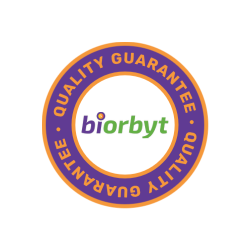You have no items in your shopping cart.
| Catalog Number | orb315804 |
|---|---|
| Category | Antibodies |
| Description | Rabbit polyclonal antibody to MTOR and is also known as LST8 and MLST8. Diseases associated with MLST8 include Benign Familial Neonatal Epilepsy and Childhood Absence Epilepsy. Among its related pathways are Constitutive Signaling by AKT1 E17K in Cancer and RET signaling. Q9BVC4 Subunit of both mTORC1 and mTORC2, which regulates cell growth and survival in response to nutrient and hormonal signals. mTORC1 is activated in response to growth factors or amino acids. Growth factor-stimulated mTORC1 activation involves a AKT1-mediated phosphorylation of TSC1-TSC2, which leads to the activation of the RHEB GTPase that potently activates the protein kinase activity of mTORC1. Amino acid-signaling to mTORC1 requires its relocalization to the lysosomes mediated by the Ragulator complex and the Rag GTPases. Activated mTORC1 up-regulates protein synthesis by phosphorylating key regulators of mRNA translation and ribosome synthesis. mTORC1 phosphorylates EIF4EBP1 and releases it from inhibiting the elongation initiation factor 4E (eiF4E). mTORC1 phosphorylates and activates S6K1 at Thr-389, which then promotes protein synthesis by phosphorylating PDCD4 and targeting it for degradation. Within mTORC1, LST8 interacts directly with MTOR and enhances its kinase activity. In nutrient-poor conditions, it stabilizes the MTOR-RPTOR interaction and favors RPTOR-mediated inhibition of MTOR activity. mTORC2 is also activated by growth factors, but seems to be nutrient-insensitive. mTORC2 seems to function upstream of Rho GTPases to regulate the actin cytoskeleton, probably by activating one or more Rho-type guanine nucleotide exchange factors. mTORC2 promotes the serum-induced formation of stress-fibers or F-actin. mTORC2 plays a critical role in AKT1 Ser-473 phosphorylation, which may facilitate the phosphorylation of the activation loop of AKT1 on Thr-308 by PDK1 which is a prerequisite for full activation. mTORC2 regulates the phosphorylation of SGK1 at Ser-422. mTORC2 also modulates the phosphorylation of PRKCA on Ser-657. |
| Species/Host | Rabbit |
| Clonality | Polyclonal |
| Tested applications | IF, IH, WB |
| Reactivity | Human, Mouse, Rat, Sheep |
| Immunogen | KLH-conjugated synthetic phosphopeptide corresponding to residues surrounding S2448 of human mTOR protein. The exact sequence is proprietary. |
| Dilution range | WB: 1-500:1000, IHC-P: 1-100:200, IF/ICC: 1-100:500, IP: 1-10:100 |
| Form/Appearance | Liquid in 0.42% Potassium phosphate, 0.87% Sodium chloride, pH 7.3, 30% glycerol, and 0.01% sodium azide. |
| Conjugation | Unconjugated |
| Target | MTOR |
| Entrez | 56717, 56718, 2475 |
| UniProt ID | P42345, Q9JLN9, P42346 |
| Source | Rabbit |
| Storage | Shipped at 4°C. Upon delivery aliquot and store at -20°C for one year. Avoid freeze/thaw cycles. |
| Buffer/Preservatives | Liquid in 0.42% Potassium phosphate, 0.87% Sodium chloride, pH 7.3, 30% glycerol, and 0.01% sodium azide. |
| Alternative names | anti-FRAP antibody, anti-FRAP1 antibody, anti-FRAP Read more... |
| Note | For research use only |
| Expiration Date | 12 months from date of receipt. |
Li, Meng et al. Melatonin Inhibits the Ferroptosis Pathway in Rat Bone Marrow Mesenchymal Stem Cells by Activating the PI3K/AKT/mTOR Signaling Axis to Attenuate Steroid-Induced Osteoporosis Oxid Med Cell Longev, 2022, 8223737 (2022)
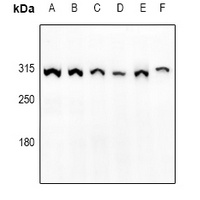
Western blot analysis of mTOR (Phospho-S2448) expression in MCF7 (A), SGC7901 (B), LO2 (C), AML12 (D), H9C2 (E), rat testis (F) whole cell lysates. (Predicted band size: 288 kD; Observed band size: 289 kD)
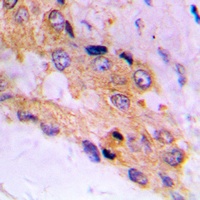
Immunohistochemical analysis of mTOR (Phospho-S2448) staining in human prostate cancer formalin fixed paraffin embedded tissue section. The section was pre-treated using heat mediated antigen retrieval with sodium citrate buffer (Phospho-H 6.0). The section was then incubated with the antibody at room temperature and detected using an HRP conjugated compact polymer system. DAB was used as the chromogen. The section was then counterstained with haematoxylin and mounted with DPX.
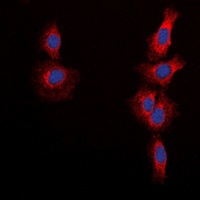
Immunofluorescent analysis of mTOR (Phospho-S2448) staining in MCF7 cells. Formalin-fixed cells were permeabilized with 0.1% Triton X-100 in TBS for 5-10 minutes and blocked with 3% BSA-PBS for 30 minutes at room temperature. Cells were probed with the primary antibody in 3% BSA-PBS and incubated overnight at 4 °C in a hidified chamber. Cells were washed with PBST and incubated with a DyLight 594-conjugated secondary antibody (red) in PBS at room temperature in the dark. DAPI was used to stain the cell nuclei (blue).
mTOR (phospho-Ser2448) antibody [orb6452]
FC, IHC-P
Bovine, Canine, Equine, Rabbit, Sheep
Human, Mouse, Rat
Rabbit
Polyclonal
Unconjugated
200 μl, 100 μl, 50 μlMTOR (Phospho-S2448) antibody [orb571560]
ELISA, IF, IHC, WB
Human, Mouse, Rat
Rabbit
Polyclonal
Unconjugated
50 μg, 100 μgMTOR (Phospho-S2448) antibody [orb572556]
ELISA, IF, IHC, WB
Human
Rabbit
Monoclonal
Unconjugated
50 μl, 100 μl
Filter by Rating
- 5 stars
- 4 stars
- 3 stars
- 2 stars
- 1 stars

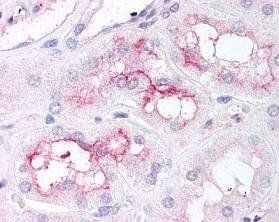
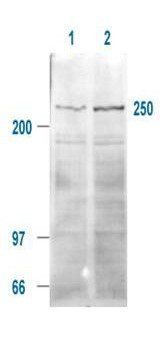
_antibody_orb6452_ihc_p_1.jpg)
